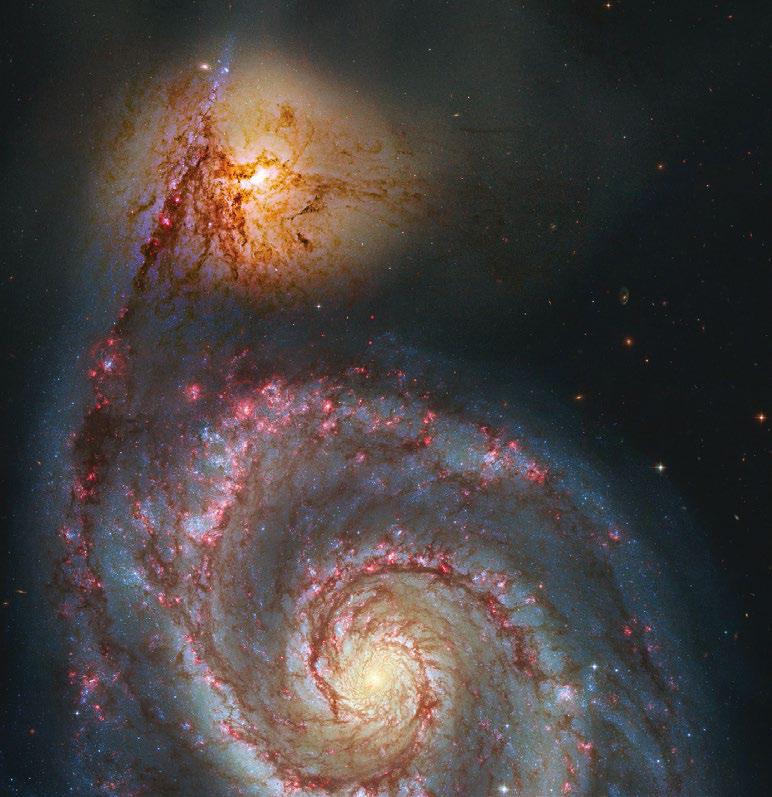Try GOLD - Free
WHAT IF THERE WAS NO GRAVITY?
How It Works UK
|Issue 179
How this fundamental force controls the way things move on Earth and throughout the universe

Gravity is something we all take for granted. It’s the force that holds us to the surface of the Earth and what makes things fall. But it’s much more than that, too. It’s what holds Earth together and gives the planet its roughly spherical form. It’s what keeps Earth moving in its orbit around the Sun, ensuring that we always have the heat and light we need to live. In fact, gravity is one of the most fundamental things in the universe – the force that holds everything from asteroids to galaxies together.
Gravity is one of four fundamental forces, alongside electromagnetism and the two types of nuclear force. On very small scales it’s by far the weakest of these forces, but it comes into its own at large distances. That’s because the nuclear forces have a very limited range, while electromagnetic forces tend to get cancelled out because electric charge can be either positive or negative. Gravity, on the other hand, always acts in the same direction – it’s a force of attraction, which means there’s no limit to its range. And it’s a very democratic force, operating with equal effect between any two objects having mass. For these reasons, it’s far and away the most important force governing the universe on large scales.

This story is from the Issue 179 edition of How It Works UK.
Subscribe to Magzter GOLD to access thousands of curated premium stories, and 10,000+ magazines and newspapers.
Already a subscriber? Sign In
MORE STORIES FROM How It Works UK

How It Works UK
UNCANNY'S DANNY ROBINS
The creator and host of the BBC's Uncanny series tells us about his most chilling experiences while researching the show, and writing a ghost book for children
4 mins
Issue 208

How It Works UK
HOW FEATHERS GROW
A bird's proteinaceous plumage comes from the same source as our hair
1 mins
Issue 208

How It Works UK
New EV battery technology could power 500-mile road trips on a 12-minute charge
Scientists have used a neat chemistry trick to tackle a major challenge facing future batteries.
2 mins
Issue 208

How It Works UK
HOW AIR PURIFIERS WORK
These filtration devices clean a room's air of particles that can make a person sick
1 min
Issue 208

How It Works UK
Chinese scientists hunt for alien radio signals in a 'potentially habitable' star system
TRAPPIST-1 is a red dwarf star located about 40 light years away that hosts seven Earth-sized rocky planets, with at least three orbiting in the habitable zone where liquid water could exist.
2 mins
Issue 208

How It Works UK
WHAT HAPPENS WHEN WE DIE?
Our bodies are vessels for life, but in death they undergo a cascade of chemical and biological changes
3 mins
Issue 208

How It Works UK
WHY ARE KEYBOARDS QWERTY?
There's a reason why this seemingly random arrangement of letters is widely used on keyboard layouts
1 min
Issue 208

How It Works UK
A 'quasi-moon' discovered in Earth orbit may have been hiding for decades
A new paper describes a possible 'quasi-moon' of Earth, an interloping asteroid that may have been following our planet around for decades, undetected.
1 mins
Issue 208

How It Works UK
WHAT'S AN ANTI-DRONE GUN?
How these devices intercept and disable unmanned aerial vehicles
1 mins
Issue 208

How It Works UK
Dozens of mysterious blobs discovered inside Mars may be 'failed planets'
Giant impact structures, including the potential remains of ancient ‘protoplanets’, may be lurking deep beneath the surface of Mars.
2 mins
Issue 208
Translate
Change font size
